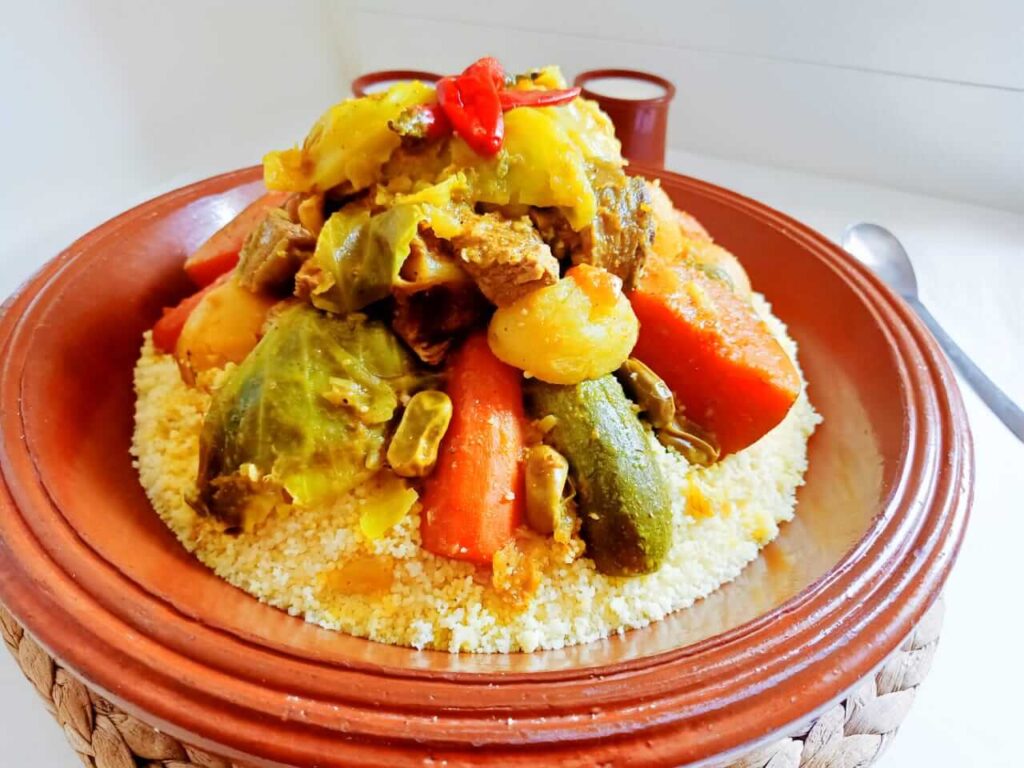Couscous: the star of the Moroccan table, embodying a 23-century heritage

History of couscous in Morocco and how to prepare it
Couscous is one of the oldest and most popular dishes in North Africa, specifically in Morocco, where it is believed to date back to the third century BC. Pottery similar to those used to prepare couscous has been found in ancient tombs from that period in the region, indicating its deep roots. It is believed that the Amazigh, the indigenous people of the Maghreb, were the first to invent this dish, which evolved from simple steamed wheat semolina into a complete meal with vegetables and meat.
During the Middle Ages, couscous spread widely in Andalusia and West Africa, and then reached Europe, especially France, via trade and migration routes. In Morocco, couscous is not just a food; it has become an integral part of cultural and social identity. It is served at major events such as holidays, weddings, and funerals, and is also a staple dish on Fridays. Preparation methods vary from region to region in Morocco, with each region boasting its own unique take on ingredients and spices, reflecting the kingdom's rich cultural diversity. In 2020, couscous was inscribed on UNESCO's Representative List of the Intangible Cultural Heritage of Humanity, in recognition of its historical and cultural significance.
How to prepare authentic Moroccan couscous (with meat and vegetables)
To prepare an authentic Moroccan couscous dish, we follow two main steps: preparing a broth rich in meat and vegetables, and then steaming the couscous semolina.
Basic ingredients:
Couscous: Wheat semolina (preferably medium or fine grain).
Meat: Medium cuts of beef or lamb.
Vegetables: Onions, carrots, turnips, cabbage, pumpkin, zucchini, soaked chickpeas.
Spices: Turmeric, ginger, black pepper, salt.
Additions: Country butter, olive oil, a bunch of parsley and coriander, peeled and chopped or crushed tomatoes, hot pepper (optional).
Preparation steps:
Preparing the broth:
In a large pot (preferably a couscous pot), sauté the chopped onion in olive oil until wilted, then add the meat pieces and sauté until they change color. Add the spices (turmeric, ginger, black pepper, and salt) and tomatoes, stirring well to combine the flavors. Pour in enough water to cover the meat and add the parsley, coriander, and soaked chickpeas. Bring the broth to a boil, then reduce the heat, cover, and let the meat cook until halfway cooked. Once the meat is halfway cooked, add firmer vegetables such as carrots, turnips, and cabbage. Shortly before the end of cooking, add vegetables that require less cooking time, such as red squash and zucchini, and chili peppers, if desired.
* Steaming couscous (tafoor):
First shift: Place the couscous semolina in a large bowl and sprinkle with a little oil. Rub it with your hands to coat each grain and break it apart. Gradually sprinkle the couscous with salted water, rubbing it in continuously until the water is absorbed and the grains are moist. Place the couscous in the top of a couscous pot (couscoussier), which sits above a pot of simmering broth. Let it steam for 15–20 minutes (until steam begins to rise vigorously from the couscous).
Second shift: Lift the couscoussier and empty the couscous into a large plate. Sprinkle with salted water again and break it up by hand or with a wooden spoon (as it will be very hot). A tablespoon of oil or ghee may be added at this point. Let it rest and absorb the water. Then return it to the couscoussier and steam again for another 15–20 minutes.
The third shift (Optional but makes the couscous softer): Repeat the same second step (sprinkling with water and ghee and re-boiling) to get softer, more cooked couscous.
Submission:
After the couscous is fully cooked and the broth is ready, pour the couscous into a large serving dish (kasaa) in the shape of a pyramid. Make a hole in the center to arrange the meat and vegetables around it. Pour the hot broth over the couscous, and additional broth can be served in a side bowl for those who want more.
Additional tips for perfect couscous
To prepare unforgettable Moroccan couscous, here are some additional tips that will make a big difference in the flavor and texture:
Semolina type: Use medium-grain couscous semolina for best results.
Impregnation and ventilation: Give the couscous enough time to fully absorb the water between pourings, and air it well to break up any clumps.
Authentic country butter: Country butter is the secret behind the deep, rich flavor. Add a tablespoon of it at the end of the dish and before serving.
Vegetable balance: Use a variety of seasonal vegetables, and avoid overcooking them.
Sufficient broth: Always make sure there is enough broth to cover the couscous.
A touch of sugar and salt: Some regions add a small touch of sugar to the broth to balance the flavors, adjust the salt to taste.
Submission: Arrange the couscous in a pyramid shape in the bowl, arrange the meat and vegetables in a beautiful way, and decorate the dish.





